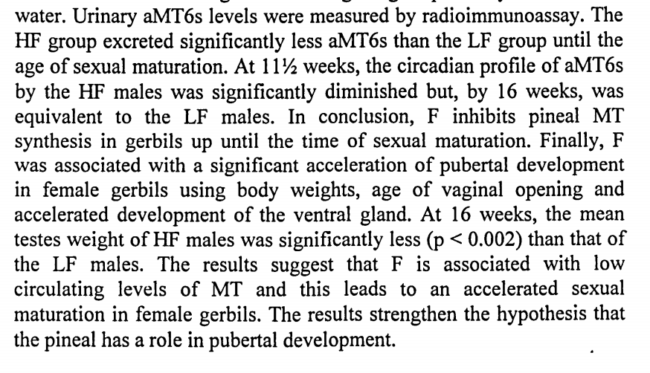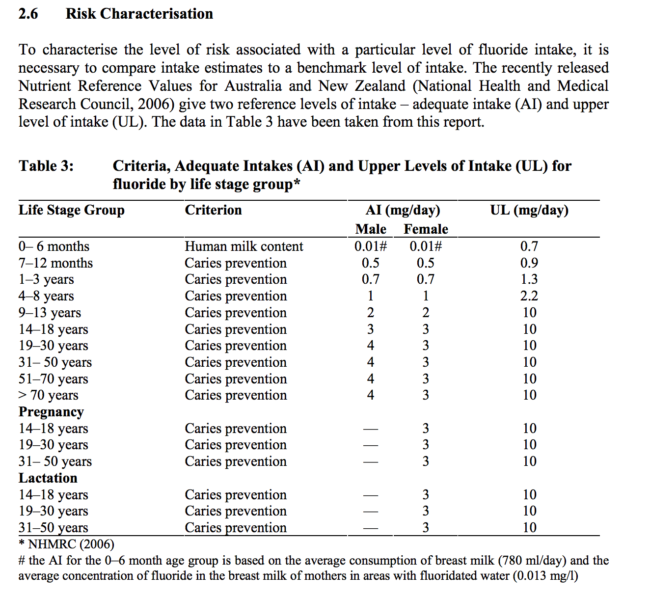Fluoride in Auckland's Water
The idea is that fluoride replaces calcium in the tooth making it harder and stronger. Calcium is also used in memories, bones, and many other places in the body.
Gerbils, The Pineal, and Melatonin
Melatonin. You might have heard of it. It's a neurotransmitter responsible for making you go to sleep at night and I think it peaks around 8 or 9pm at night say.
In this study they found that fluoride that had replaced calcium in the pineal gland had significantly. The guts of it is here:

..blah blah blah...

thusly proving we might be bring on the onset of puberty in girls, shrinking our balls, and making it hard for our kids to get to sleep.
UPDATE: Found out today - remembered also - that calcium bridges in the synapse form memories, I wonder how fluorine affects these? Fluorine replaces calcium in this stuff called "The Brain Sand" or Corpora_arenaea:
calcified structures in the pineal gland and other areas of the brain. Older organisms have numerous corpora arenacea, whose function, if any, is unknown. Concentrations of "brain sand" increase with age, so the pineal gland becomes increasingly visible on X-rays over time, usually by the third or fourth decade.
I asked the city council about quantity and quality of fluoride in our water. Here is their reply...
Fluoridated Water
Fluoride is often added to drinking-water for oral health reasons, prevention of teeth decay. The Ministry of Health recommends fluoride concentration between 0.7-1.0 mg/L as the optimal concentration for that purpose. The maximum acceptable level of fluoride in drinking water is 1.5 mg/L. The addition of fluoride is done at the request of our consumers.
Any change to this position would be directed to Watercare though the Auckland Council.
Treatment chemicalsFluoride is added to the treated water at the water treatment plants. There are couple of options available for drinking water fluoridation: Hydrofluosilicic acid, Silicofluorides, Sodium Fluorosilicate and Sodium fluoride.
To guarantee the use of the treatment chemicals in their purest form the water treatment companies use reputable suppliers. These suppliers have quality control measures in place to ensure that the supplied chemicals are free of any potential contaminants.
Dose concentrationWhen fluoride is deliberately added to water, dose control is important to maintain the concentration within the specified allowable limit. The control measures at the treatment plants are:
- Â Â Â Fluoride is delivered at the dose concentration so there is no risk of dosing a more concentrated solution;
- Â Â Â Fluoride dosing is flow proportional, its concentration is always in correlation to the volume of water being treated;
- Â Â Â Treatment plants utilise continuous on-line monitoring for fluoride concentration in the treated water;
- Â Â Â Alarms are triggered if the fluoride concentration has reached the set level.
Source: Correspondence Agent
www.watercare.co.nz
Using their intranet URL http://wsldctmos1:8080/sites/KnowledgeBase/resources/Pages/ProcessDetail.aspx
Source of NZ Fluoride for Water?
Found this detail about NZ fluoride -Â it seems to be made by Farmers Fertiliser Ltd:
In the New Plymouth works of Farmers Fertiliser Ltd the scrubbing process has been modified so as to produce an acid suitable for water fluoridation. In this works the scrubbing I-Chemicals-C-Hydrofluorosilicic acid-3 process is divided into three stages with acid of different concentration in each. This yields an acid containing about 20% H2SiF6 which is acceptable to local authorities. The superphosphate article has a flowsheet showing a typical scrubber installation for hydrofluorosilicic acid production. Water and gas are made to flow countercurrent to each other so that gas rich in fluoride is contacted by strong acid and gas weak in fluoride meets very dilute acid. Strong acid is pumped away from the first scrubber and settled to remove silica before being sold.
This part about "demand sufficient to justify economic recovery" sounds disturbing:
This process removes fluoride from the gas stream, thus preventing an environmental hazard,
but it does have its problems. The 20% acid is very corrosive to most metals, so scrubbing
equipment is more costly than that used with plain water sprays. However, the demand in the
North Island is sufficient to justify economic recovery.
Solution
I'll admit since it's in mothers milk it must be all goods. I'd just prefer Sodium Fluoride (salts) at 10x what a baby gets than the 70x baby dose of cheaper more toxic but less effective liquid one we get. Oh and also..... being part of someones un-monitored science experiment.

Ginko Biloba To The Rescue
“The Y-maze test has been widely used to evaluate cognitive abilities. The test involves recording the CRT [correct reaction time]. . . . The CRT of the NaF group on the 9th day decreased significantly (p<0.01, vs. control group). The CRT of the rats treated with EGb [ginko bilboa extract] significantly increased compared to the rats that received fluoride and saline (p<0.01). After 2 weeks, the Y-maze test was performed again to test the CRT. As showed in Fig. 1c, the CRT of the EGb group was significantly more than that of the NaF group (p<0.01). This result suggested that EGb could improve learning and memory impairment induced by chronic fluoride exposure in rats.â€
SOURCE: Zhang C, et al. (2013). The analog of ginkgo biloba extract 761 is a protective factor of cognitive impairment induced by chronic fluorosis. Biological Trace Element Research 153:229-36.